Wireless Interconnect Smoke Alarms operate like animals in a herd. Instead of being stand-alone devices, they are manufactured to talk among themselves (interconnect).
This is possible through the transfer of information (signals) via a ‘mesh network.’ The network allows the smoke detectors to integrate and provide better safety and security against fire or accidents.
Fire does not keep within one room or one corner. It can spread within the blink of an eye. Interconnected smoke alarms can detect smoke anywhere in the house. Then the alarm goes off in every room smoke detector is present.
Wireless smoke alarms are much better than wired ones but also have disadvantages. This helps the house owners become aware of the likely onset of fire in one corner of the house. Keep reading to know more.
Can Wireless Smoke Detectors Be Interconnected?
Quick Navigation
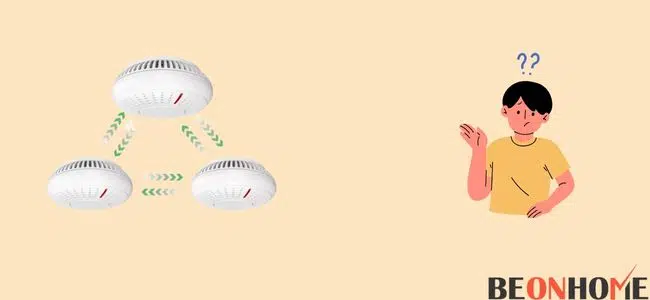
Most wireless smoke detectors or fire alarms manufactured a decade ago could not be interconnected. They were powered by batteries and functioned as stand-alone devices. Each room had a separate and individually working fire alarm.
Smoke detectors manufactured within a decade now more or less had the feature of being interconnected. Yes, these wireless smoke detectors can talk to each other.
- This is possible via a radio-frequency connection.
- Wired interconnected smoke detectors work by signaling each other via AC signals.
- The working mechanism remains the same, except they no longer need to be hardwired.
- All of the detectors across the house still need to be connected to the primary system circuit of the house.
- This is where they will get the power from.
On detection
- On detection of smoke or fire by a particular sensor, that sensor sends off a signal through radio frequency (RF)
- The alarms further connected to the same mesh network will start to sound their alarm after one gets the signal. The signal will spread like a web.
On average, a maximum of 12 units of alarms can function adequately on the same red wire.
How Do Wireless Interconnected Smoke Detectors Work?
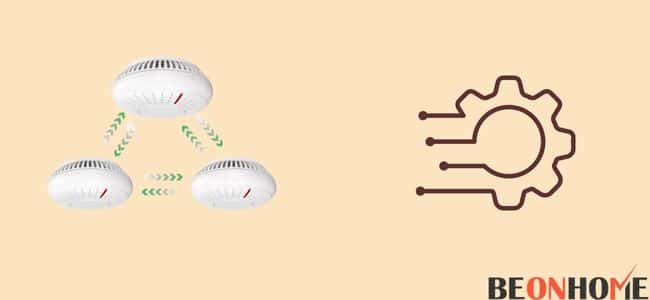
- Wireless smoke detectors use radio signalling and other technologies to detect fire onset at any house corner.
- Popular smoke detector like the First Alert Smoke detector uses 65,000 security code combinations to link to the other sensors.
- Many security codes ensure no interference with other fire alarms from adjacent houses.
- They work through radio-frequency signalling instead of signalling through the AC volts as the wired ones do.
- All you have to do before installing them is to connect them wirelessly in a group. Once they are connected and synced, you can install them in the desired rooms of your house.
- The alarms work by sending, receiving, and resending the signals via the radio frequencies.
- This ensures that no information gets cut off due to interference from any other source.
- In case of interference at any part of the house, the alarms will automatically re-route and resend the signal via other notices to save you from a fire breakout.
- These radio signals can travel a very long distance and cover a large area ~ 150 meters or more.
Do Interconnected Smoke Alarms Need To Be On The Same Circuit?
Yes. For the alarms to work together, they have to be initially connected to the main power supply of your house.
Power can be supplied from a convenient pendant light—persistent (non-switched) live feed to where the alarm is placed.
But there is no need to interconnect the alarms to each other. This will occur via radio-frequency signalling. This saves much installation time and will help improve the house’s overall look. The inlet to supply power to interact its alarms should be according to your alarm’s preferences, You can have a good low budget 30 amb inlet or a high-quality 50 amp inlet for your alarm.
Advantage Of Wireless Interconnected Smoke Alarms Over The Wired One
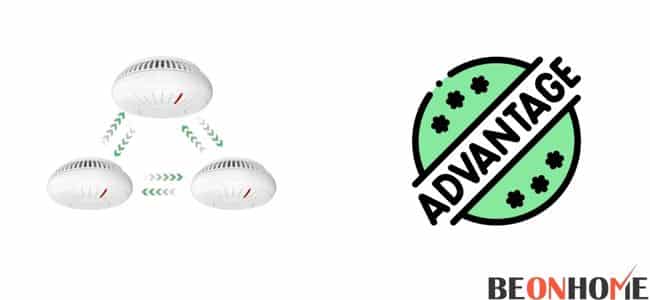
- The main advantage of the wireless interconnected smoke detectors is mainly the wireless part.
- Setting up and installing the wired smoke detectors take much more time and effort and hence costs a lot of money.
- They have a wide range and can cover a larger area with minimal effort needed in installation.
- If you ever decide to expand your alarm system, you can do it quite easily by following the same processes of installation mentioned above.
Do All First Alert Smoke Detectors Communicate With Each Other?
No. Only the smoke detectors set for interconnection can connect with others. That is to say, the ones having the ONELINK linking program will only be able to connect and communicate with the other devices.
How Do You Sync Wireless Smoke Detectors?
- Insert batteries (2 AA) into the smoke detectors.
- Set the location of the detector. For, e.g., Bedroom, This can be done by long-pressing the Test button.
- Now to integrate and sync it with other devices, insert batteries into the battery drawer of another detector. Now don’t close the drawer.
- Press and hold the test button until the device makes a beep or chirp sound, and then you can close the battery drawer.
- Once you hear the sound, release the button.
- A green LED of power will start to blink. This indicates that the linking program is waiting for other devices to connect.
FAQs
Here are some FAQs about the interconnected smoke detector that might answer your queries.
1. Can Wireless Smoke Detectors Be Interconnected?
We can now set up wireless interconnected smoke detectors. This is an excellent option for folks leasing their house or not wanting to perform any maintenance on it. But what exactly are these alarm systems?
We can interconnect smoke detectors now using various technological advancements. Interconnected smoke alarms detect fires using radio transmitters and other technologies. They are networked throughout your home’s system. They will notify you if a fire breaks out in another region, giving you enough time to escape your property. When they detect a concern, all of your home’s alarms go off simultaneously to help them locate possible risks in other locations. Even if a single alarm goes off, notifying everyone inside is the most significant advantage of these interconnected smoke detectors.
2. Do Interconnected Smoke Alarms Need To Be On The Same Circuit?
The connecting can be accomplished by either a hardwire connection or a wireless link. It is essential that when hardwiring interlinked smoke detectors, they must all be hooked to the same circuitry. Furthermore, the maker may impose limits on the number of alarms that may be networked as well as the range between interconnected alarms. Newly constructed homes or buildings are outfitted with mains-powered interconnected smoke detectors. These sensors can be linked to the other alarms in the system through hardwired wires or radiofrequency (wireless).
3. How Do Wireless Smoke Alarms Connect?
There are two ways in which smoke alarms can communicate with each other. One is radiofrequency, and the other is a mesh network.
Wireless smoke alarms use radio waves to interact. This helps to communicate wirelessly with others in the identical type series. Wireless smoke alarms emit a signal that is distinctive to the model. All smoke detectors have their frequency band that is pre-decided. On the back of each wireless alarm, there are dip switches. When the Test/Reset switch is clicked, and all controls are set to the same configuration, all smoke alarms will beep.
Wireless Link smoke detectors use a “mesh network” to link smoke alarms for improved safety and responsiveness in an emergency. These alarms All First Alert Wireless Interconnect alerts the send, receive, and resend the signal from the starting alarm. Assume the signal is obstructed from contacting the kitchen alarm due to distance or a barrier in the home. The mesh network of Interconnect alarms re-routes and resends the message via the other sensors. This increases the likelihood that all notices will receive the signal. The “mesh network” is a more dependable wireless communication method.
4. How Many Wireless Smoke Detectors Can Be Interconnected?
According to NFPA 72 guidelines, the maximum of smoke detectors that should be interlinked is 12. Always double-check that the smoke alarms you’re attaching are compatible. In addition to the series’ 12 smoke alarms, you may attach up to 6 suitable devices such as door closers, bells, or lamps.
Requirements for interconnecting smoke detectors:
1) A total of 18 suitable devices can be linked together (A maximum of 12 Smoke Alarms).
2) All interconnected equipment must be powered by the same circuit or MCB
3) The total length of cable linking the units should not exceed 1000 ft (300 meters). 4) This wire is often found at all electrical stores. You can also find this at hardware stores.
5) All wiring must adhere to all local power requirements and NFPA 70. (NEC). For more information on connection requirements, consult NFPA 72, NFPA 101, and your local building code.
5. Can You Disconnect One Interconnected Smoke Alarm?
You could be able to utilize the same wire harness if you buy a smoke detector from the same brand. Remove the old smoke alarm and replace it with the new one. You, too, can accomplish it.
1) Of course, switch off the power first to be cautious.
2) Turn off the electricity.
3) To loosen your smoke alarm, twist it.
4) Unplug your smoke detector from its electrical harness.
5) Unlock all bolts that secure the mounting bracket.
6) Take away the mounting bracket.
7) Disconnect the existing wires from the previous wiring harness.
8) Install the new wire harness.
9) Insert the cables into the holes.
10) Replace the mounting bracket.
11) Install the new smoke detector.
12) To secure the new smoke alarm, twist it.
13) Reconnect the electricity.
14) Check the smoke detector.
15) You can interconnect the new smoke detector to your set radio frequency once done. This will help in communication with the rest of the smoke detectors. Many manufacturers provide a manual for this connection. Read through the manual and set the new detector to the frequency of communication. So now you have a replaced smoke alarm that communicates flawlessly.
Final Talk
Now you know every detail of the interconnected wireless fire alarms. They will save you money, time, and effort in installation due to their way of mechanism. All you need to do is connect them to the main power supply, and that’s it. The interconnected alarms will be able to warn you a lot quicker about a minor breakout in any part of the house, giving you enough time to evacuate and take other measures.
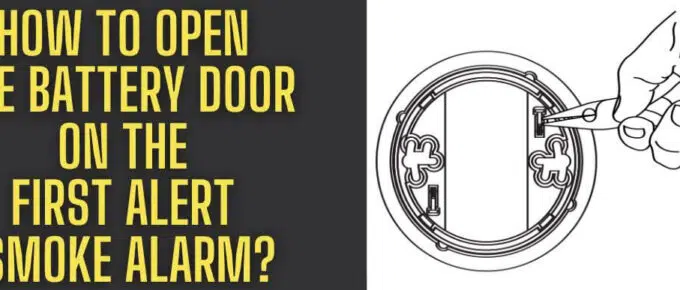
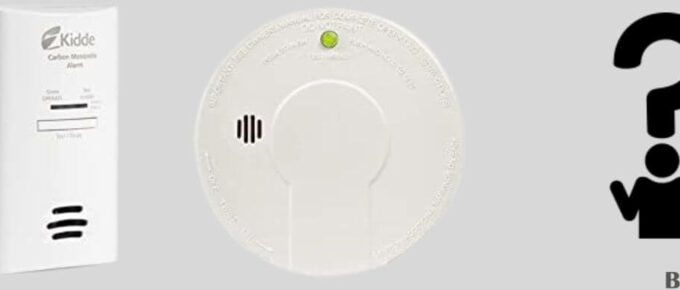
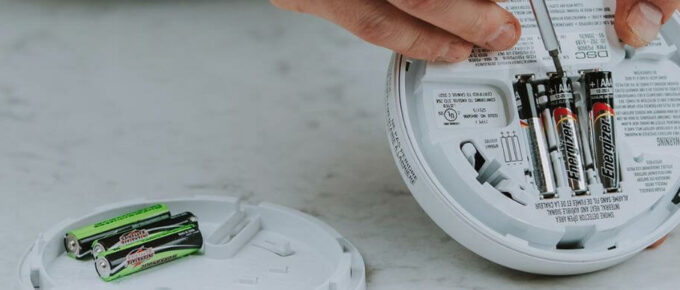
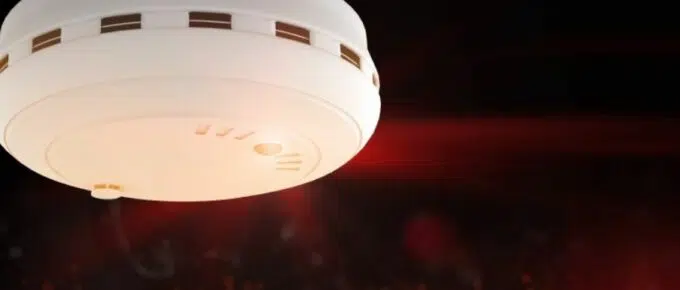
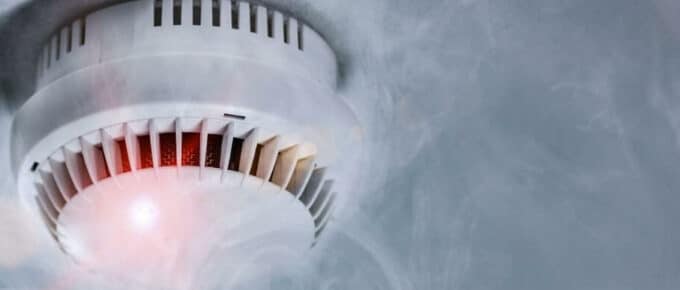
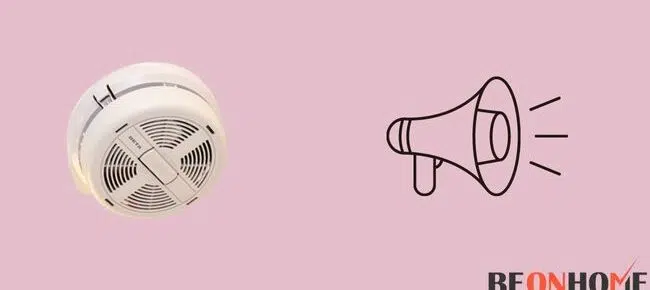
Leave a Reply